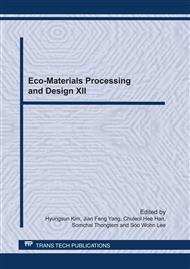p.429
p.433
p.437
p.441
p.445
p.449
p.453
p.457
p.461
Ultrasound-Enhanced Electrochemical Preparation of Atomic Oxidants
Abstract:
The atomic oxidant was prepared under conditions of ultrasound and non-ultrasound. The influence of electrolysis time, electrolyte concentration, electrolysis voltage and additive concentration on concentration of oxidant were investigated. The results show that ultrasound could enhance the perpetrating rate. For ultrasonic cavitation and chemical effect, the concentration of oxidant significantly increased. Under the condition of electrolysis time 3 hours, voltage 6V, 35% sulfuric acid concentration and 0.5g/L additive, the ultrasonic frequency 40kHz and power 150W, the effect of oxidation could get the best result, and the oxidant concentration reached 0.9177mol/L.
Info:
Periodical:
Pages:
445-448
Citation:
Online since:
July 2011
Authors:
Keywords:
Price:
Сopyright:
© 2011 Trans Tech Publications Ltd. All Rights Reserved
Share:
Citation:


